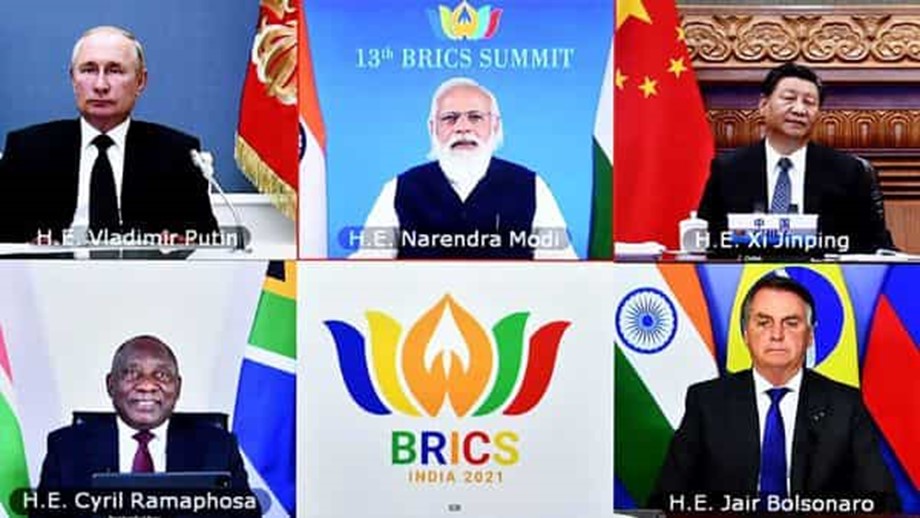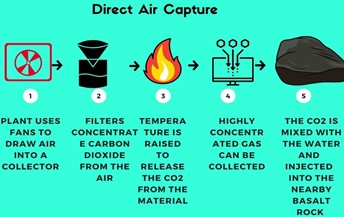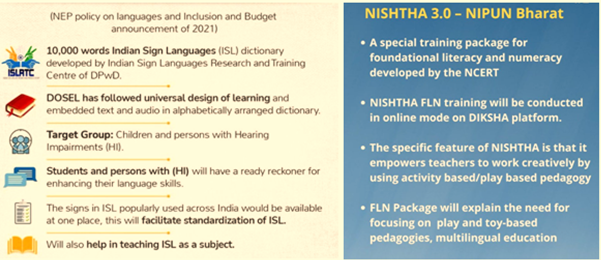Monday, 13th September 2021
CRISPR technology to control growth of mosquitoes
In News
Researchers at the University of California have created a new system that restrains populations of the mosquito species, Aedes aegypti.
About the news
- About: Leveraging advancements in CRISPR-based genetic engineering, researchers have created a system that restrains populations of mosquitoes that infect millions each year with debilitating diseases.
- Technique: The precision-guided sterile insect technique (pgSIT) is a genetic engineering method based on CRIPSR-Cas9 method.
- Functioning: It alters genes linked to male fertility and female flight. Thus, the pgSIT uses CRISPR to sterilise male mosquitoes and render female mosquitoes (which spread disease) flightless.
- The pgSIT eggs can be shipped to a location threatened by mosquito-borne disease or developed at an on-site facility that could produce the eggs for nearby deployment. Once the pgSIT eggs are released in the wild, sterile pgSIT males will emerge and eventually mate with females, driving down the wild population as needed.
- Safety feature: The system is self-limiting thus not to persist or spread in the environment.
- Self-limiting (biology): An organism or colony of organisms which limits its own growth.
- Significance: The new system can be immensely useful to control the spread of Aedes aegypti, which is responsible for spreading diseases including dengue fever, chikungunya and Zika.
About CRISPR-Cas9 Technique
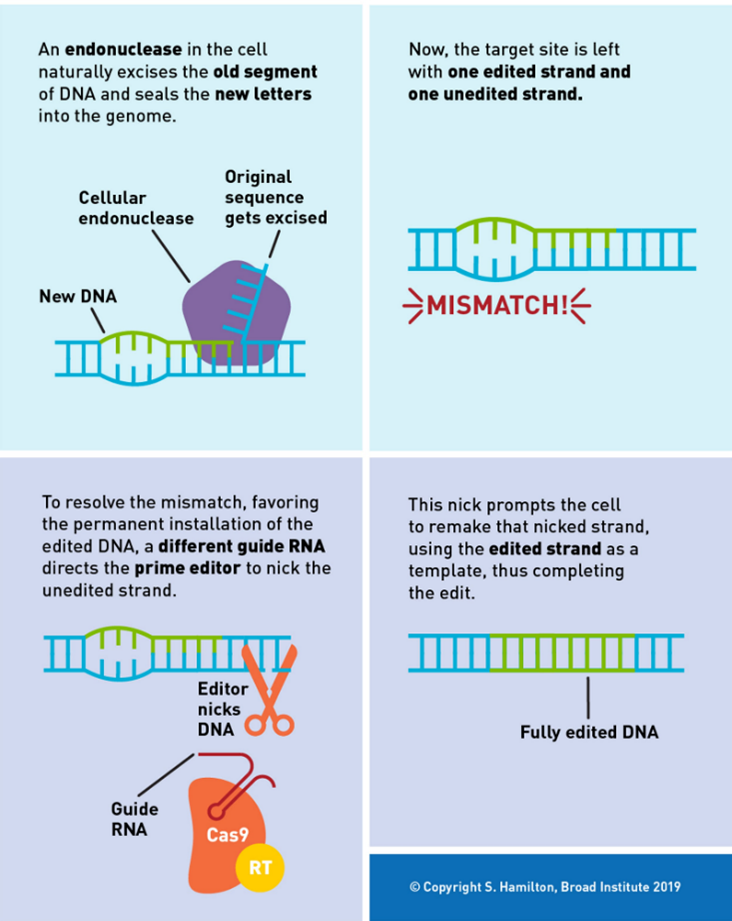
- About: CRISPR is an acronym for Clustered Regularly Interspaced Short Palindromic Repeat and Cas9 is an acronym for CRISPR-associated. It is a technology that can edit parts of the genome by removing, adding, or altering sections of the DNA sequence.
- Components:
- Cas9 is an enzyme which acts like a pair of molecular scissors to cut strands of DNA at a specific location.
- Guide RNA (gRNA) which consists of a piece of pre-designed RNA sequence. The scaffold part binds to DNA and the pre-designed sequence ‘guides’ Cas9 to the right part of the genome to edit.
Source:
Food safety labels on the front side: FSSAI
In News
India’s food safety authority, FSSAI has decided to put food safety labels on the front side of packaged.
About the News
- About: The Food Safety and Standards Authority of India (FSSAI) has decided to put food safety labels on the front side of packaged food depending on the harm fat, sugar and salt cause to human health.
- Food Industry: The food industry has been reluctant to have front of package food safety labels, implemented in some other countries such as Brazil and Chile, clearly stating if the product is healthy for people or not.
- In India, the processed food industry is believed to be US $ 44 billion in value and growing at a rapid pace of about 24% every year.
- Current Status of Labels: The labels usually show the ingredients in the packed food, informing about the salt, sugar and fat content. It also provides for any significant health warning that the consumption of food could cause
- New Label: Five types of labels were being considered including traffic light signs, nutrition score, health star ratings, warning symbols. Each label type has its positives and negatives, he added.
Significance of the Move
- Consumption Reduction: A 2018 study in Brazil and Chile on impacts of food-safety labeling on people has shown that it leads to reduction in consumption of ultra-processed food products, which are considered bad for human health.
- Negative Repercussions: As per the WHO, the high consumption of processed food can lead to obesity and non-communicable diseases, which account for 71% or 41 million deaths, every year, globally.
- India’s Status: AS per the FSSAI’s 2020 study on pre-packaged food products, India has become the third biggest consumer of processed food by the end of 2021, after China and the United States, with sales volumes of over 34 million tonnes.
Concerns about labelling
- As per the food industry the label should inform the consumer about the guideline about the quantity of salt, sugar, sodium and fats in the food packet without giving health warning.
- The reason provided is that the consumer should take an informed decision and not get discouraged from consuming the packaged food.
- The consumer groups want labels to clearly state whether the food is healthy for human consumption, as most consumers would not know how much sugar, salt or fat is good or bad for their health, if only quantity is specified.
FSSAI Guidelines on Labelling of Food Products
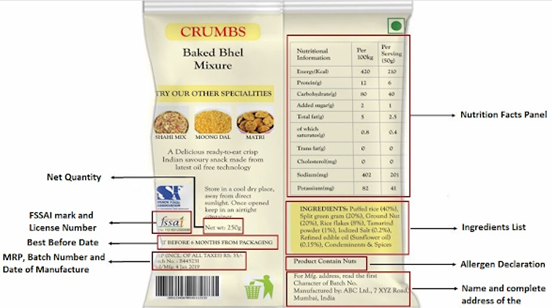
Sources:
Image Source :
NIRF Ranking 2021
In News
The 6th annual ranking list of higher educational institutes of the country has been released by the National Institutional Ranking Framework (NIRF).
About the News
- About: This year roughly 6,000 education institutions participated in NIRF. The ‘Research Institutions’ category has been added this year.
- Overall category: IIT Madras has topped the Rankings in the overall category, while IISc Bengaluru has come second, which is followed by IIT Bombay at the third place.
- College category: Under the best college category, Miranda House has again topped the list this year. Lady Shri Ram College for Women of Delhi and Loyola College of Chennai has secured the second rank and third rank respectively.
- Research: The research category was introduced this year and IISc-Bangalore has been adjudged the best, followed by IIT-Madras and IIT-Bombay.
- Among the top 10 research institutes, IITs have dominated the category with seven positions in the research category.
About the NIRF Ranking
- Ministry: The National Institutional Ranking Framework, NIRF is the Ministry of Education's college and university ranking exercise.
- Origins: The ranking framework was launched in 2015 and the first annual ranking list was declared in 2016.
- Ranking Parameters: The ranking framework judges institutions under five broad generic groups of parameters of

- Categories:

Source:
PLFS: 2019-2020
Featured News of the Day
PLFS: 2019-2020
In News
National Statistical Office (NSO) has recently released the third annual report of the Periodic Labour Force Survey (PLFS) for the year 2019-20.
Key Findings of the PLFS (2019-2020)
- Labour indicators: It recorded an all-round improvement in 2019-20 compared with the previous two years.
- The unemployment rate: It fell to 4.8 per cent in 2019-20. In 2018-19, it stood at 5.8 per cent and 6.1 per cent in 2017-18.
- Worker Population Rate: It has improved to 38.2% in 2019-20 compared with 35.3% in 2018-19 and 34.7% in 2017-18.
- Labour Force Participation Ratio (LFPR: It has increased to 40.1% in 2019-20 from 37.5% and 36.9%, respectively, in the last two years.
- Gender Based Unemployment Rate: The Unemployment rate for both male and female fell to 5.1% and 4.2%, respectively, in 2019-20 from 6% and 5.2% in 2018-19.
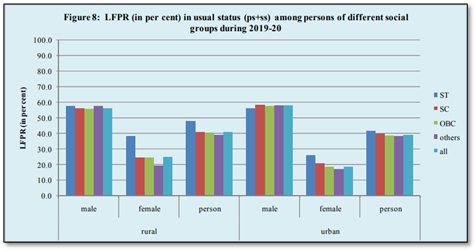
About the Periodic Labour Force Survey
- Origins: Considering the importance of availability of labour force data at more frequent time intervals, National Statistical Office (NSO) launched Periodic Labour Force Survey (PLFS) in April 2017.
- Objectives: The objective of PLFS is primarily twofold:
- To estimate the key employment and unemployment indicators (viz. Worker Population Ratio, Labour Force Participation Rate, Unemployment Rate) in the short time interval of three months for the urban areas only in the ‘Current Weekly Status’ (CWS).
- To estimate employment and unemployment indicators in both ‘Usual Status’ (ps+ss) and CWS in both rural and urban areas annually.
- Employment Classification: PLFS categorises the workforce into self-employed (which includes own account workers, employers, and unpaid helpers in family enterprises); regular wage/salaried workers and casual labourers.
- Key Employment and Unemployment Indicators
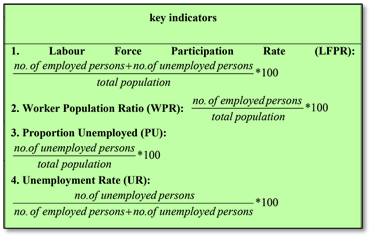
What do the Findings of the Report Reflect?
- Labour Force Participation in Agriculture: The share of the labour force engaged in agriculture rose to 45.6 per cent in 2019-20, up from 42.5 per cent in 2018-19. Thus, during this period of stress, agriculture emerged as an “employer of last resort”.
- Women’s labour force participation: There has been an increase in the women’s labour force participation in the category of unpaid family workers, and not in more productive forms of employment. This is indicative of rising
- Work Participation Rate (WPR): The overall work participation rate for men has remained at the same level during this period. A small increase has been observed in the self-employed worker category for rural and urban areas and for regular salaries in the urban sector.
- The significant jump in the WPR for rural women in unpaid family work and casual work indicate distress driven employment and not necessarily any improvement in the overall economic activity.
- Workforce Distress: The proportion of the urban workforce dependent on services has gone up from 69.3% to 71.8% over 2017-18 to 2019-20. The proportion of the rural workforce in agriculture has gone up from 59.4% to 61.5% over the same period. Such trends suggest an overall increase in workforce distress.
- Labour Under-utilization: Only 60% of our population is not available to our labour force, and only 38.2% of our population is employed. China stands in stark contrast on this yardstick, with about 66.8% of its labour force actively employed or seeking employment and 63.5% of its population employed in 2020.
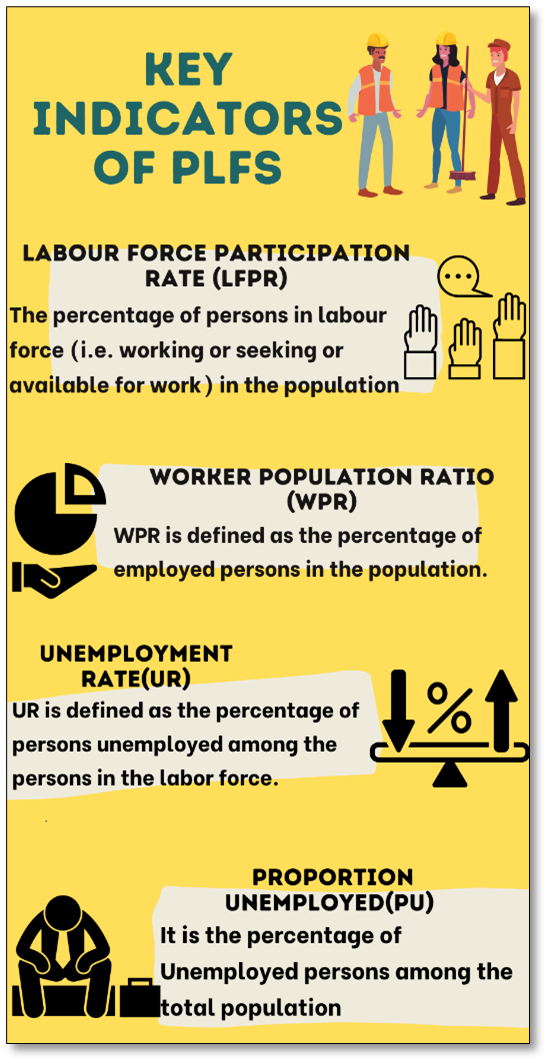
Limitations of the PLFS
- Year Long period of Survey: The reference period of one year that is used by the survey an unduly optimistic picture of the unemployment numbers. Within the PLFS itself, the unemployment reported for the period July 2019 to March 2020, is much higher, at 8.5 %. In the quarter from April to June 2020, this unemployment rate shot up to 20.9%.
- Misplaced Indicator: The survey only reflects the improved employment scenario for women, but does not indicate the informalization of female workforce.
- Although, both the WPR and UR have declined considerably in the last quarter of 2019-20 and the recovery in the subsequent quarters is uncertain in the face of the continuing impact and second wave of the pandemic.
Conclusion: The PLFS survey 2019-20 has revealed deeply entrenched issues pertaining to the quality of employment being generated in India. More importantly, it has shown how current measures of capturing unemployment may be woefully inadequate in assessing the magnitude of the joblessness problem in India and the true extent of labour under-utilization.
Question: Discuss the results of the Periodic Labour Force Survey 2019-2020 on the basis of the key indicators. What do the results of the survey reflect about the labour force of the economy?
Sources:
- Periodic Labour Force Survey (PLFS)
- Labour Force Survey data underlines strain in labour market, lack of job creation in non-agri sectors
- PERIODIC LABOUR FORCE SURVEY (PLFS
- Third annual report on Periodic Labour Force Survey (PLFS):
- Periodic Labour Force Survey 2019-20: What does it tell us?:
- What India’s labour force survey actually says about employment:
Jatindra Nath Das
On 13 September, 1929, Jatindra Nath Das, an Indian revolutionary who fought for the country's freedom, breathed his last in Lahore jail. Das was arrested in the Lahore Conspiracy Case and was imprisoned in Lahore jail. While being lodged at the Lahore jail, Das and other revolutionaries began a hunger strike, demanding equality of Indian political prisoners with Europe. He breathed his last on the 63rd day of the strike. Born in Calcutta on October 27, 1904, Das went on to become an important figure in India's freedom struggle. Das also participated in the Non-Cooperation movement in 1921, when he was just 17-years-old.

Source:
Chandni Chowk
This is image of restored and redeveloped of Chandni Chowk, a 400-year-old legacy that has been a part of Delhi since the Mughal era. With CCTVS, significantly reduced overhead cables and a beautified walkway has been pedestrianized. The redeveloped Chandni Chowk has facilities like toilets, water ATMs and dustbins for pedestrians to walk without inconvenience. It has 'divyang' friendly tactile flooring as well. Four earthen and sandstone signages have been installed on which information has been given in Hindi, English, Urdu and Punjabi.
The redevelopment plan, which started in 2018, had hit many snags.

Source:
Acharya Vinoba Bhave - Edukemy Current Affairs
- Context: Acharya Vinoba Bhave’s birth anniversary.
- Acharya Vinoba Bhave was born at Gagode in Kolaba district, Maharashtra on 11th September, 1895.
- He was a nonviolence activist, freedom fighter, social reformer and a spiritual teacher. He was an avid follower of Mahatma Gandhi and upheld his doctrines of non-violence and equality.
- Bhave brought out a monthly in Marathi, named, `Maharashtra Dharma' that comprised of his essays on the Upanishads and on Swarajya Sastra, Geeta Pravachane, Teesri Shakti or The Third Power etc.
- He is best known for his 'Bhoodan Movement' (Gift of the Land) and was the first recipient of the international Ramon Magsaysay Award for Community Leadership in 1958.
- He was also conferred with the Bharat Ratna (India's highest civilian award) posthumously in 1983.
Source:
Image source:
Protectors of Emigrants (POEs)
- Context: The Fourth edition of Conference of Protectors of Emigrants was held recently, which also coincided with the date of enactment of the Emigration Act 1983.
- POEs are responsible for granting emigration clearance to the intending emigrants as per the procedure prescribed under the Emigration Act, 1983, and work under the general superintendence and control of the Protector General of Emigrants.
- eMigrate system is an online platform which helps the POEs to integrate POE offices, passport offices, Indian missions, Bureau of Immigration and helps regulate overseas employment.
- Powers of Protector of Emigrants:
- To protect and aid all intending emigrants and emigrants and oversee all the provisions of the Emigration Act.
- Inquire into the treatment received by emigrants during their voyage, their return and during the period of their residence in the country to which they emigrated.
Source:
Image source:
ATL Space Challenge 2021
- Context: Niti Aayog's Atal Innovation Mission in collaboration with ISRO and CBSE has launched 'Space Challenge' for school students across India.
- It aims to ensure that students of classes 6 to 12 are given an open platform where they can innovate and enable themselves to solve digital age space technology problems.
- This challenge has been designed for all the school students, mentors and teachers across the country who are associated with both ATL (Atal Tinkering Labs) and non ATL schools.
- The aim of this challenge is to enable innovation among young school students to create something in space sector that will not only help them learn about the space but create something that the space programme can use itself.
- Atal Innovation Mission (AIM) is the Government of India’s flagship initiative to create and promote a culture of innovation and entrepreneurship across India.
Sources:
Battle of Saragarhi
- Context: September 12, 2021 was the 124th anniversary of the Battle of Saragarhi, which has inspired a host of armies, books and films.
- The Battle of Saragarhi is considered one of the finest last stands in the military history of the world. Twenty-one soldiers were pitted against over 8,000 Afridi and Orakzai tribals but they managed to hold the fort for seven hours.
- Saragarhi was the communication tower between Fort Lockhart and Fort Gulistan. The two forts were built by Maharaja Ranjit Singh but renamed by the British. The heliograph communication system, which uses sunlight and mirrors to flash messages via the Morse code, was operated by at the fort.
- Queen Victoria awarded the 21 dead soldiers of the 36th Sikh the Indian Order of Merit (comparable with the Victoria Cross) along with two ‘marabas’ (50 acres) and Rs 500 each.
- In 2017, the Punjab government decided to observe Saragarhi Day on September 12 as a holiday.

Source:
Image Source:
At 15, BRICS has made incremental progress. But there is a palpable disconnect too- HT
Essence: The article talks about the achievements of BRICS in its 15 years of existence, and outlays further milestones for BRICS. The 13th summit of BRICS was held virtually and was chaired and hosted by Prime Minister Narendra Modi. Afghanistan’s disturbing political situation could be viewed by many in South Africa and Brazil as a peripheral issue, but it is of vital concern to key Asian players China, Russia, and India. During the summit, top leaders committed themselves towards “the priority of fighting terrorism, including preventing attempts by terrorist organizations to use Afghanistan as a terrorist sanctuary and to carry out attacks against other countries”. The Achilles heel of this formulation, however, is China’s which shows readiness to recognize Taliban based government in Afghanistan and its support for Pakistan's misadventures. The gap between Beijing’s actions and words poses a potential vulnerability challenge for the BRICS. BRICS presented its faith in “representative and effective multilateralism”.
The group’s futuristic goals now include diverse realms such as customs, digital health, green tourism and space, technology for sustainable development goals of 2030. The economic initiatives included the New Development Bank which is attracting a global dimension.
Why should you read this article?
- To understand the 15 years of journey of the BRICS and future development initiatives.
- To understand the significance of Afghanistan’s situation for the BRICS nation and why China is at a leverage point.
Source:
Labour and care during India’s Covid crisis
Essence: Article exposed the limitations and challenges of medical staff, infrastructure and care during COVID- 19 pandemic. Patient’s family, social media, etc are being utilized as the last resort. “The doctor-patient relationship” must grow and place greater value on the work of nurses, technicians, orderlies, cleaners, and morgue workers in hospitals, as well as the extraordinary efforts of patients’ relatives to secure and fund care.
Why should you read this article?
- To get an overview of labour care in India and issues associated with them.
- To understand what possible steps should be taken to resolve the issues associated with them.
Source:
Edible Oil Mission: Good idea but not enough
Essence: Article exposed the limitations and challenges of medical staff, infrastructure and care during COVID- 19 pandemic. Patient’s family, social media, etc are being utilized as the last resort. “The doctor-patient relationship” must grow and place greater value on the work of nurses, technicians, orderlies, cleaners, and morgue workers in hospitals, as well as the extraordinary efforts of patients’ relatives to secure and fund care.
Why should you read this article?
- To get an overview of labour care in India and issues associated with them.
- To understand what possible steps should be taken to resolve the issues associated with them.
Source:
Plastic Waste Management: Power of 3
Background
- Almost 79 per cent of the total plastic generated are dumped in wastelands.
- A viral social media post led 3 women from Maharashtra to initiate the Milk Bag Project (MBP).
How this plastic waste management initiative worked
- Demonstration: Imbibing practical knowledge as to how to recycle the milk bags to the people.
- Sensitisation: They began with their own homes to process the waste milk bags.
- Employment generation: Employing people for collection and factory recycling of the bags.
- Outcome: They curbed plastic pollution by processing 7.5 lakh plastic milk packets.
Quote
“There is no such thing as away. When we throw anything away, it must go somewhere.” – Annie Leonard
Where can it be used:
Paper 1: Role of women in development
Paper 2: Conservation, Environmental Pollution and Degradation
Source:
Share the article
Get Latest Updates on Offers, Event dates, and free Mentorship sessions.

Get in touch with our Expert Academic Counsellors 👋
FAQs
UPSC Daily Current Affairs focuses on learning current events on a daily basis. An aspirant needs to study regular and updated information about current events, news, and relevant topics that are important for UPSC aspirants. It covers national and international affairs, government policies, socio-economic issues, science and technology advancements, and more.
UPSC Daily Current Affairs provides aspirants with a concise and comprehensive overview of the latest happenings and developments across various fields. It helps aspirants stay updated with current affairs and provides them with valuable insights and analysis, which are essential for answering questions in the UPSC examinations. It enhances their knowledge, analytical skills, and ability to connect current affairs with the UPSC syllabus.
UPSC Daily Current Affairs covers a wide range of topics, including politics, economics, science and technology, environment, social issues, governance, international relations, and more. It offers news summaries, in-depth analyses, editorials, opinion pieces, and relevant study materials. It also provides practice questions and quizzes to help aspirants test their understanding of current affairs.
Edukemy's UPSC Daily Current Affairs can be accessed through:
- UPSC Daily Current Affairs can be accessed through Current Affairs tab at the top of the Main Page of Edukemy.
- Edukemy Mobile app: The Daily Current Affairs can also be access through Edukemy Mobile App.
- Social media: Follow Edukemy’s official social media accounts or pages that provide UPSC Daily Current Affairs updates, including Facebook, Twitter, or Telegram channels.

